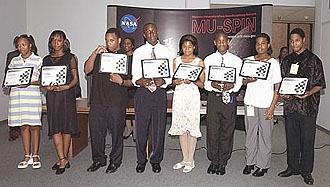Feature
Starting Young
09.09.04
| Who Are NASA's Earth Explorers? The elementary school student questioning if El Niño occurs anywhere besides the Pacific Ocean. The researcher investigating connections between Arctic ozone depletion and global climate change. The citizen scientist interested in how changing land cover and use affects animal migration patterns. And the businessperson projecting future needs for harvest, delivery and storage of crops. All of these people are Earth Explorers -- they are all connected by their curiosity about Earth system processes. This monthly series will introduce you to NASA Earth Explorers, young and old, with a variety of backgrounds and interests. Nominate an Earth Explorer! Tell us about Earth Explorers you know! We're looking for students, teachers, scientists and others who are working with NASA Earth science data and imagery to better understand our home planet. Send your nominations to Dan Stillman: dan_stillman@strategies.org. |

|
Is urban growth driving animal species out of their habitats? Do hurricanes cause more severe damage than tornadoes? How do forest fires affect animal populations?
These were some of the questions investigated recently, not by graduate scholars or professional scientists, but by middle and high school students participating last school year in the NASA Student Involvement Program's Watching Earth Change competition.
NSIP is a national science competition for K-12 students working in teams, as a class or individually. There are six competition categories designed to foster science, math, technology and geography skills. Watching Earth Change challenges students to use NASA data and information to test their own hypotheses about how Earth is changing.
Students from Drew Freeman Middle School and Duval High School in Prince George's County, Md., submitted several projects to Watching Earth Change. They developed hypotheses and conducted research under the guidance of their teachers and specially assigned science mentors.
The mentors -- students from nearby University of Maryland and Bowie State University -- were provided as part of a program sponsored by NASA's Minority University-Space Interdisciplinary Network and run by the Prince George's County Workforce Services Corp.
NSIP goes a step beyond typical classroom science work, according to Phil Sinsky, an education consultant for the Workforce Services Corp.
"It allows students not only to learn about science, but actually to do science," said Sinsky, who managed the mentor program. "It also helps students learn to communicate more clearly and effectively."
Michael English, head of the science department at Drew Freeman, says that NSIP also teaches kids the importance of teamwork.
"Because they worked in groups, each individual member held the other member responsible for their part," English said. "The students began to take ownership, and responsibility emerged."
To test their hypotheses, the students looked at satellite images, examined climate statistics, read articles on the NASA Web site, and researched facts and information elsewhere on the Internet.
While the students did part of their work after school, some had to be done during the regular school day, which sometimes meant pulling students out of their normal classes. Any initial resistance from other teachers quickly dissipated once English explained that what they were doing complemented, rather than competed with, the curriculum.
"The teachers realized that the students were involved in a project that did involve their discipline," English said. "So whereas they might have been missing a math lesson, the students actually did have math computation and math application within their particular task depending on which project they chose."
The NSIP Web site offers tips from teachers who have incorporated NSIP into their curriculum and includes information about the national education standards supported by the program.
Watching Earth Change is open to students in grades 5-12. K-4 students looking to explore Earth with NSIP can do so through the My Planet Earth competition.
The Minority University-Space Interdisciplinary Network provides various opportunities for minority students to become Earth Explorers through its Network Resources and Training Sites and other programs located at colleges and universities across the country.
This article has also been written for K-4 and 5-8 reading levels. These versions can be accessed through "+For Students K-4" and "+For Students 5-8".
See previous Earth Explorers articles:
+ View site
Related Resources
NASA Student Involvement Program (NSIP)
+ View site
Minority University-Space Interdisciplinary Network
+ View site